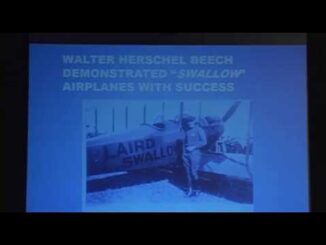Did You Know That…??!!
by Frank Joseph Rowe
“Long forgotten but highly significant historical facts that played a major role in the evolution of the aviation industry.”
…Charles
Lindbergh’s famous transatlantic solo flight in 1927 spawned the formation
of nearly 40 new aircraft manufacturing companies in Kansas. Such was
the excitement generated by Lindbergh’s flight that public interest supported
an unprecedented demand for new aircraft. It would last for only a few
years until the effects of the Great Depression would curtail this growth.
…At
one time, Walter Beech, Clyde Cessna and Lloyd Stearman all worked together
at one company. In the early 1920′s, all three world-prominent aircraft
designers would work at the Travel Air Manufacturing Company in Wichita,
Kansas. Shortly thereafter, philosophical differences pertaining to the
way each thought aircraft should be designed would cause Stearman to leave
to form Stearman Aircraft Company, Clyde Cessna would leave to form Cessna
Aircraft Company and Walter Beech would stay on at Travel Air to evolve
the company into Beech Aircraft Company.
…That
during the Great Depression that occurred in the Fall of 1929, many aircraft
companies went out of business. Some of the ones that managed to hang
on built inexpensive (under $1,000) , ultra-light weight (around 500 lbs)
aircraft known as “Flivver’s” that would typically be powered
by a 25 HP 2 cycle engine such as the American Eagle “Eaglet”
built in Kansaa City Kansas. Other attempts to ride out the depression
resulted in manufacturers building personal single-place gliders such
as the Cessna CG-2.
…Bill
Lear, the multi-talented entrepreneur and originator of the Learjet, summed
up his marketing philosophy as thus, “the trick is to discern a market
before there is any proof that one exists”. The fact that the general
public still associates the name “Learjet” as being synonymous
with corporate jet aviation underscores the enormous impact of Bill Lear’s
vision.
…One
of the lesser known, but most highly respected Kansas aircraft manufacturers
was the Helio Aircraft Company. Headquartered in the suburbs of Boston,
Massachusetts, and with it’s main manufacturing facility in Pittsburg,
Kansas, Helio produced some 530 examples of the much vaunted “Courier”
and “Stallion” series of C-STOL aircraft between 1954 and the
mid 1980′s. The Helio Courier was called the “tennis court airplane”
due to it’s ability to take-off and land in the length of a tennis court.
Conceived as an “every-person’s, affordable safety airplane”,
the Helio evolved into a high-dollar aircraft with it’s market restricted
in large part to military usage (particularly CIA). In the hands of a
seasoned Helio pilot, the Courier is capable of performing an incredible
display of low and high speed handling that has yet to be challenged.
…The
original design of the Learjet 23 (originally called the SAAC 23) was
based in part on the Swiss P-16 Ground Attack Fighter. Most noticeable
lineage can be seen in a comparison of the wing shape / planform.
…Jacob
Melvin Moellendick , often reffered to as the “father of Wichita
aviation”, used his skills as a venture capitalist in the oil industry
to help underwrite the start-up of the first successful Wichita aircraft
production company E. M. Laird Aircraft Company (1919) and later in the
Swallow Aircraft Manufacturing Company. In 1918, oil field production
(largely focused in Eldorado, Kansas (as well as parts of Oklahoma) yielded
approximately 80,000 barrels a day. A portion of the profits from “black
gold” were plowed back into supporting an industry that continues
to thrive and set world standards for aviation.
…That
during World War II, the production worker ranks at local aircraft companies
averaged between 50 – 60 % women. With an unprecedented number of working
women in the aviation factories the stage was set to underscore the future
job opportunities for women in what was prior to WWII , a mostly male-dominated
work-force. During the war, workers averaged 10 hour work days with every
other weekend off.
Note: Aviation historical author, Frank Joseph Rowe is Senior Multi-Disciplinary Engineer at Beechcraft. Rowe was formerly with Cessna as Supervisor, Advanced Design.


